About the Artworks
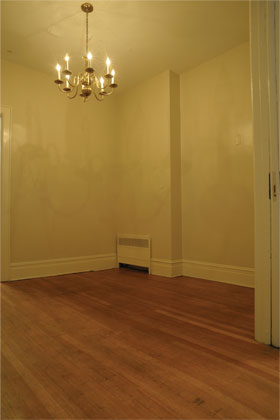 |
Edgar Arceneaux
Edgar Arceneaux's Sound Cannon Double Projection creates an unsettling feeling inside house 404 on Colonels Row. It's difficult to pinpoint-a sensation in the gut, a movement seen in peripheral vision, an eerie, low-pitched sound. Inspired by the plethora of abandoned historic houses on the island, with their disorienting floor plans and almost palpable strangeness, Arceneaux created an installation that employs "infrasound" speakers (emitting very low-frequency sound waves below 20 Hz) to heighten visitors' uncanny experience of the existing architecture. Researchers have suggested that infrasound might be present in certain allegedly haunted locations, and cause feelings of uneasiness. It has been claimed that infrasound can also cause people to experience bizarre feelings such as anxiety, extreme sorrow, paranoia, or even the chills. |
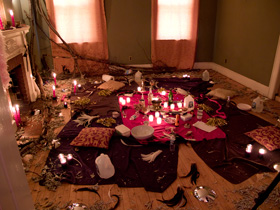 |
AA Bronson & Peter Hobbs AA Bronson and Peter Hobbs' Invocation of the Queer Spirits (Governors Island), a séance held here on June 25, 2009, invoked historical, queer, and marginalized practices as a way to heal the past and acknowledge the present. As Bronson described, the ritual includes "drawing a circle, asking for protection, and invoking the spirits, naming the various histories and communities of the dead." This intervention underscores how queer communities have overlapped with the histories of Spiritualists and shamans, as well as all-male communities such as the military population that called Governors Island home. Inspired by the countless lives and deaths that took place on the island, the project invites us to think again about what is valued and what is excised from our collective history. The physical remains of the ritual are presented here. |
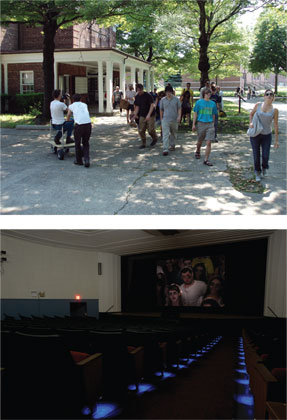 |
The Bruce High Quality Foundation Art collective The Bruce High Quality Foundation's film Isle of the Dead tells the story of a decimated art world coming back to life in zombie form. "The basic arc of Isle of the Dead," as the Foundation describes it, "is that the art world has died-literalizing its economic death-and risen from the dead in search of an alternative space, Governors Island." At the heart of Isle of the Dead is an anxiety about the current state of the art world and a skepticism about the idea that the recent collapse of the market will necessitate a renewal of the radical art practices of the late sixties and seventies in New York City. The film critiques this kind of nostalgia-a yearning for a simpler time that often overshadows a more complex analysis of the historic circumstances that inform the present. As they say, "The idea of reanimation really resonates with us. We're a fictional foundation for a fictional dead artist. The Bruce High Quality Foundation is the afterlife." |
 |
Adam Chodzko In Adam Chodzko's film Echo, the artist tells the story of the children of Governors Island military personnel who secretly gather in the basement of the Officers' Club to play an invented game. The object of the game is to be the apparent loser in a deal: a car is swapped for a joke; a house for a view. Our dominant economic value system is turned on its head in Chodzko's film, and the person who rids her or himself of the most material possessions is the one who comes out on top. The film echoes the initial trade of Governors Island by Native Americans to Dutch settler Wouter van Twiller for "two axe heads, a string of beads, and a handful of nails," and the 2003 sale of the island by the Federal Government to the people of New York State for just one dollar. Chodzko's film, which blends original and archival footage, proposes new relationships between our emotional and economic value systems, the communal and private spaces that generate these systems, and the documents and fictions that describe and guide them. |
 |
Tue Greenfort Continue ahead to see Tue Greenfort's Project for the New American Century. This site, called Brick Village, was part of a post-WWII residential community and is scheduled for demolition in the redevelopment of Governors Island. The words "Project for the New American Century" are spelled out on the side of one of the buildings, the individual letters cut from the building's interior walls, doors, flooring, window shades, and shelves. The phrase is inspired by the conservative think-tank that promoted US militarization and hegemony abroad. Greenfort uses Governors Island's redevelopment as a metaphor to explore which aspects of our history we choose to preserve, and thus privilege. In this site on the verge of transformation, Greenfort's project urges viewers to pause and reflect on the choices we make, and how they may inform us about centuries past as well as those ahead. |
|
Jill Magid For the exhibition publication, Magid will provide a proposal for an unrealized project for the Governors Island ferry. |
 |
Teresa Margolles Teresa Margolles' Muro Baleado is a cinder-block façade relocated from the artist's home city of Culiacán, Mexico. It is pockmarked with bullet holes and bears specks of what seem to be dried blood: the results of a deadly shooting linked to organized crime. Culiacán, known as "Narco City," has an active underground economy based on the trafficking of illicit drugs-and on its streets, shootings are commonplace. In a performance over the course of this exhibition's opening weekend, a Mexican masonry crew reassembled the wall here in Nolan Park. Margolles' work invents new ways to remember, mourn, and reflect on the dead through their physical impressions on the world. It is impossible to ignore, as well, the link between the shooting that occurred in front of this wall and international counterdrug policy. This artwork's scarred surface reflects the histories of violence in two countries and the wall that runs between them. |
 |
Anthony McCall Anthony McCall's work encompasses three distinct sets of practices: the sculptural, the pictorial, and the cinematic. Consisting of two elegantly simple light projections, Between You and I expands on the two basic components of cinema-time and light-in order to create a spectacular, immersive environment. As the projected light beams slowly travel through mist, they begin to carve out sculptural shapes in space. The fields of light interact with one another, the visitors in the space, and the striking architecture of historic St. Cornelius Chapel. Though the two shapes never meet, they are in a constant play-suggesting that, like two human companions, they attempt to comprehend themselves in relation to one another. |
 |
Nils Norman Nils Norman's deserted tent city recalls the nomadic, impermanent architecture of activists-from the sixties counterculture movement to the 2005 camp in Crawford, TX that protested the war in Iraq-as well as the homeless encampments that have recently emerged in Sacramento, Portland, Reno, and other cites. Visitors to Norman's installation are asked to contemplate the camp among the many architectural ruins on Governors Island, including the nearby Castle Williams. This tent city is, like its neighboring relics, abandoned and dormant; it acts as a reminder that once-vibrant strategies for activism and alternative living have passed into obscurity, and that structures are sometimes as malleable as symbols. |
 |
Susan Philipsz By My Side is an original recording, in two-part harmony, of a song of the same name from the 1971 musical Godspell. Both parts of the harmony are sung by the artist, and play from speakers on Lima Pier, directed toward the Statue of Liberty and the waterfront of Governors Island. "I have chosen to sing a devotional song, a song of love and adoration that addresses the statue directly," the artist said about this project. The song asks, "Where are you going? / Where are you going? / Can you take me with you?" The female character in Godspell who sings "By My Side" is a cast-out, and the artwork can be interpreted as the melancholy yearning of a lone figure on a disused pier who can only watch as people and ships pass by. This outsider character is mirrored in the position of the Statue of Liberty, standing apart from the city and watching over the harbor. |
 |
Patti and Jesse Smith Click here to download Messages in a Bottle as an MP3 Patti and Jesse Smith's spoken word poetry and musical composition Messages in a Bottle takes the form of an elegiac meditation upon the history, present, and future of Governors Island. Experienced intimately through headphones, it provides companionship, a whisper and melody in the ear as one wanders the island. Artist and musician Patti Smith collaborated with her daughter Jesse, an accomplished pianist, to make this audio work-Jesse created a soundscape to accompany the words and thoughts of her mother. An alternative to the typical didactic tour, this work offers a poetic approach to the consideration of history, drawing upon a very personal perspective. |
 |
Tercerunquinto A few weeks before This World & Nearer Ones opened, the Mexican collective Tercerunquinto threw a rock through a window of the second floor of Liggett Hall (the large building that faces this house). On its surface, this action conveys a sense of reckless, juvenile destruction, but on a deeper level it was a calculated experiment in institutional negotiation. The buildings on the northern half of the island are protected under historic preservation guidelines-like architectural time capsules-unlike those on the southern half. The shattering of the window can be seen as a fleeting rupture in the hermetically sealed historicity of the northern section of the island-a break with the past. The window was replaced, speaking to the way that inconvenient truths may get paved over by history. |
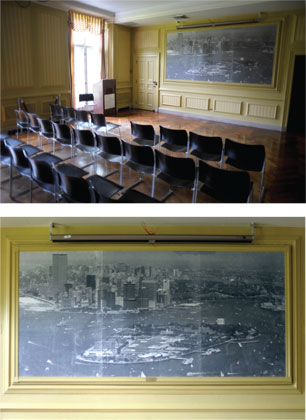 |
Tris Vonna-Michell Using his characteristic blend of storytelling, lecture, and performance, the artist will conceive a weekend performance-one tailored to the culture and history of Governors Island and that directly engages visitors individually and in groups. |
 |
Mark Wallinger Attached to the upper-deck railings of this ferry are two signs: "Goats" on the left, and "Sheep" on the right. These artworks by Mark Wallinger carry many associations. The boats that carried Dutch colonists to Governors Island in the early 17th century were named Horse, Cow, and Sheep. In the Gospel of Matthew, Jesus promises to separate all people, as a shepherd separates his sheep from his goats, based on the kindness of their deeds. Ferry is a reminder, rendered in playful terms, of the dualities that we mull over every day: good versus bad, right versus wrong, and us versus them. "The to and fro of the ferry," explains Wallinger, "is as constant as the tides. Our return is a perfect reflection of our departure." The signs are not meant to divide people as they walk aboard the ferry, but rather to encourage each passenger to consider the "back-and-forth" moments in life when she or he must assess the options, weigh the pros and cons, and ultimately choose a direction. |
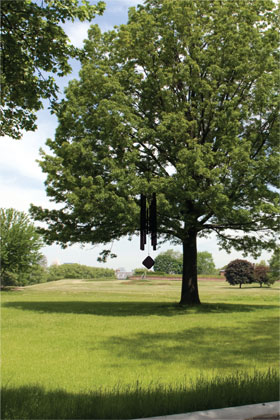 |
Klaus Weber Klaus Weber's oversized wind chime in tempered aluminum has been tuned to the mysterious diabolus in musica tritone, a musical interval that spans three whole tones, to dissonant and melancholic effect. It has been considered a "dangerous" sound since the Middle Ages, and was thought to arouse or summon the Devil. Some sources say it was outlawed for evoking sexual feelings in its listeners, while others believed that musicians could be excommunicated from the church for using it. Large Dark Wind Chime (Tritone Westy) is situated amongst rolling hills, houses of worship, Victorian buildings, and ornamental cannons, reminding us of the spirit of the age and uncertainty of our times, from global wars to economic recession and the battles that rage between good and evil. |
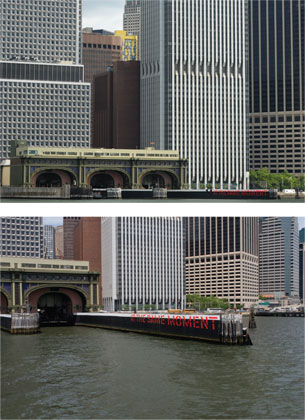 |
Lawrence Weiner As this ferry departs Manhattan, passengers can see the work of artist Lawrence Weiner: the words AT THE SAME MOMENT painted on the wooden fender rack that guides the ferry into and out of its slip. Weiner is an artist whose medium is language, and his work for This World & Nearer Ones reflects his ongoing examination of the relationship between language and physical site. Text-from the official signs in subways and on streets to the ubiquitous presence of advertising-guides our experience in the world. AT THE SAME MOMENT invites us to consider the spatial and temporal relations between two distinct places and the ferry journey that links them together. The ferry's shuttling back and forth echoes the many populations that have come and gone from the island, from the Native Americans to the Dutch and British, the US Army and Coast Guard, and the thousands of civilians who enjoy it today. As one group departs, another arrives at the same moment. As a greeting and a farewell to visitors, Weiner's text kindles a sense of this history and fleeting simultaneity in the mind of the receiver. |
 |
Judi Werthein To create La Tierra de los Libres, Judi Werthein chose to collaborate with itinerant agricultural workers from Colombia's Pacific Coast who were driven to inland cities by conflict surrounding the drug trade. To make a living in their new, urban environment, this group drew on a cultural tradition of singing while they worked and began performing in local restaurants and bars. Werthein gave the musicians a literal Spanish translation of The Star-Spangled Banner and asked them to play the song in their own style. She then filmed them performing their version and translated the fragmented and recursive lyrics back into English for the subtitles in the video. This artwork continues her exploration of the notion of "cultural integrity" and mistranslation. |
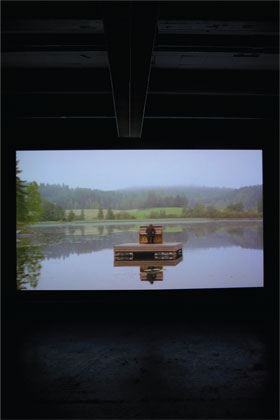 |
Guido van der Werve Guido van der Werve's films Number Four and Number Seven, selections from his "Numbered Films" series (2003-09), follow the artist as he navigates the elaborate terrain of what he calls "possible scenarios of imaginary realities." Combining a sense of dramatic suspense with poetic and incongruous activities, the artist deftly builds up an atmosphere of melancholy that can suddenly transition into light-hearted absurdity. The films suggest that, with every journey, it is impossible to return to one's place of origin fully unchanged. As visitors return from Governors Island back to Manhattan or Brooklyn, they too have been indelibly altered-perhaps in the subtlest of ways-by the adventure. |
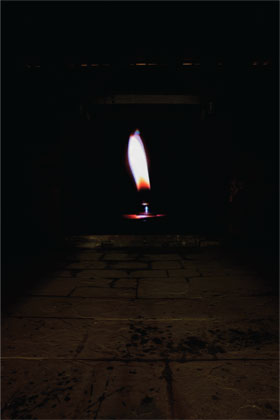 |
Krzysztof Wodiczko In Krzysztof Wodiczko's Veterans' Flame, the image of a candle flame moves with the recorded voices of veterans sharing accounts of war and its aftermath in Iraq and Afghanistan. Wodiczko conducted the interviews in April 2009, interested in having his subjects explore, through the act of remembering and retelling, the complex psychological space between the battlefield and their homes. By appropriating public buildings and monuments as surfaces for projections in his work, Wodiczko has focused on the ways in which architecture reflects collective memory, history, and the loss of life. Here, Fort Jay's silent chambers are once again filled with the voices of soldiers, and a monument to history's conflicts becomes a place to contemplate contemporary accounts of war and longing. |
